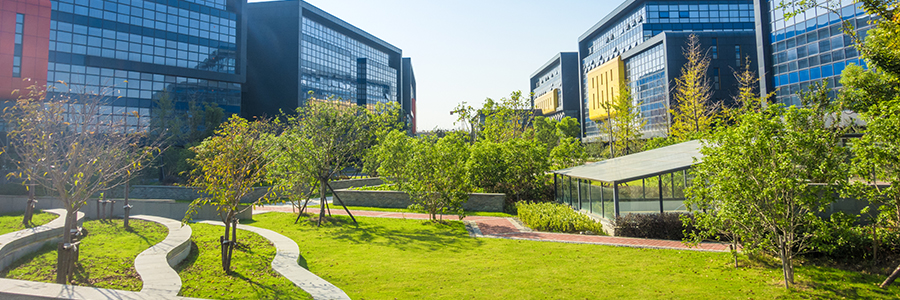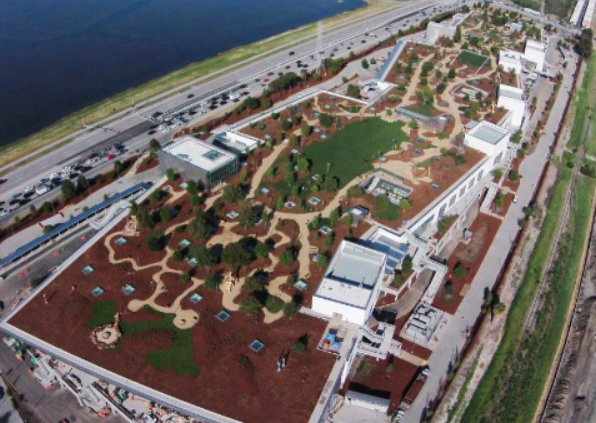
The wall of trees in the parking lot of a mall, the green roof on top of a store, the greenbelt winding through an office park…this green infrastructure isn’t just decorative; it has essential benefits — environmental, economic, and social.
On top of creating beautiful community spaces, green infrastructure (infrastructure that considers the natural environment when planning urban land use) can also make cities more resilient against climate change. As extreme weather events like severe flooding and droughts become increasingly common nationwide, we are all feeling the impacts of our rapidly changing climate.
And today’s cities weren’t designed to meet the challenges that come with this — fires, power outages, and water restrictions — just to name a few. Urban planners are rethinking the way cities are laid out and corporate campuses are integrating green infrastructure to support environmental resilience and boost people’s well-being.
In addition to green roofs and greenbelts, some other examples of green infrastructure include living walls, rain gardens, rain cisterns, urban tree canopies, wildlife crossings/overpasses, windbreaks, and fish ladders.
So, how exactly do these spaces provide environmental, economic, and social benefits? And how can we use smart irrigation solutions to help them thrive?
The Benefits of Green Infrastructure
Environmental
Well-functioning green infrastructure can increase a community’s resilience against climate change and extreme weather events, such as droughts and floods. A couple examples of this:
- Green roofs and urban tree canopies can prevent “urban heat islands” — areas in cities that experience higher temperatures due to dense pavement concentrations and buildings retaining heat. Having more trees and plants helps deflect the heat and keep these areas cooler and less polluted.
- Planting rain gardens – gardens made up of rain-tolerant plants – helps mitigate the effects of floods. These gardens absorb 30% more heavy rainfall than grass and release it slowly into the soil, reducing erosion and runoff.
Because of these numerous environmental benefits, incorporating green infrastructure like green roofs and rain gardens onto buildings are a great way for businesses to more easily meet their ESG goals. A great example of this is the green roof on the Amy’s Drive Thru in Rohnert Park, CA. It’s a beautiful symbol of their commitment to sustainability, makes their building more adaptable, and it’s irrigated with rainwater and reclaimed city water.
These green spaces can help organizations achieve sustainability goals from net zero water waste to carbon neutrality, all while making their campuses more appealing to customers and employees.
Economic
In addition to helping cities and companies adapt to climate change, green infrastructure tends to be cheaper than average “grey” infrastructure. It’s an investment that pays for itself — the damage repair after events like floods is usually much more expensive than what it would cost to build green infrastructure that reduces these harmful effects upfront.
Many programs also offer rebates and grants to incentivize businesses and residents to install green infrastructure. Companies that invest in green infrastructure can see economic benefits such as reductions in water costs, heating and air conditioning costs, and air purification costs. Infrastructure like green roofs can even increase the property value of commercial buildings, particularly in urban areas where green space is scarce.
Social and Mental
Green spaces are proven to have positive social and mental effects. They boost people’s moods, lower stress levels, and even improve focus in children. They provide community spaces in urban cities and increase residents’ social engagement and physical activity. A few examples of this in action:
- A 9-acre rooftop garden at Facebook’s Menlo Park headquarters — On top of preventing runoff into the Bay, this green roof boosts employee wellbeing, creating a space to take meetings outdoors and a chance more for community and connection across teams.

- Brooklyn Grange, two massive rooftop farms in the center of Manhattan — Not only do they prevent millions of gallons of stormwater from entering the sewer system, but these urban farms also engage the community with positive conversations about sustainability and education about nutrition. They promote community involvement by hosting events where people can connect and become a part of a positive movement.
Using Smart Irrigation to Help Green Infrastructure Thrive
As with any tree, plant, or lawn, green infrastructure needs to be cared for properly, so it can continue to thrive and provide its many positive community effects. One way to do so is with a smart irrigation system that ensures the space gets just the right amount of water at the right time.
Baseline’s smart irrigation systems are helping green infrastructure around the country thrive, such as this green roof in La Jolla, CA, and even the 9/11 memorial, Hudson Yards, and Battery Park in New York. Baseline’s soil sensors determine the amount of water in the soil to ensure it doesn’t get too hot, keeping the plant roots cool and protecting them from the scorching temperatures in these urban environments. See more examples of how Baseline smart irrigation can help green infrastructure thrive here.
Additionally, smart irrigation systems typically show an ROI of under three years, making them not only beneficial to the environment but a wise financial decision for businesses.
Want to learn more about green infrastructure and using sensor-based technology to irrigate green spaces effectively? Check out our Webinar: Improving Sustainability in Urban Areas with Green Infrastructure.

